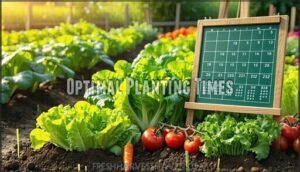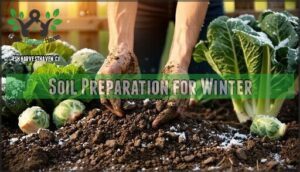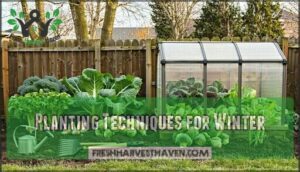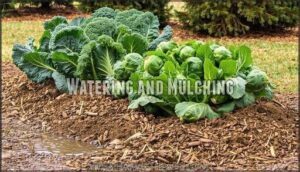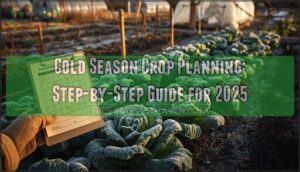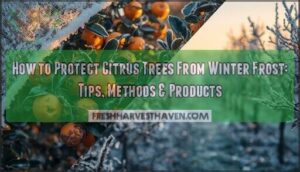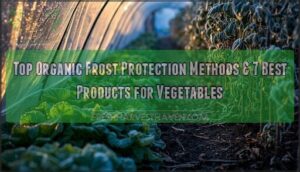This site is supported by our readers. We may earn a commission, at no cost to you, if you purchase through links.
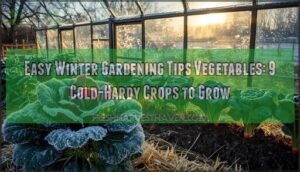
Use row covers and cold frames as your plants’ winter coats, trapping warmth while letting light filter through. Don’t forget winter mulch around plant bases to protect roots from temperature swings.
The secret lies in choosing varieties that laugh in the face of frost and knowing when Jack Frost becomes your garden’s best friend rather than its enemy.
Table Of Contents
- Key Takeaways
- Winter Gardening Basics
- Planting Winter Vegetables
- Caring for Winter Vegetables
- Harvesting Winter Vegetables
- Frequently Asked Questions (FAQs)
- What is the quickest vegetable to grow in winter?
- What are the best vegetables to grow over winter?
- What companion plants grow well with winter vegetables?
- How do winter vegetables affect soil nutrients?
- Which winter vegetables regrow after cutting?
- What organic fertilizers work best in winter?
- How do you manage garden pests in winter?
- What winter vegetables grow fastest indoors?
- Can winter vegetables survive without greenhouse protection?
- Which winter crops need least sunlight hours?
- Conclusion
Key Takeaways
- You’ll want to plant cold-hardy vegetables like kale, spinach, and carrots 10–12 weeks before your first hard frost to ensure they’re established before winter hits.
- Use row covers and cold frames as protective barriers that’ll trap warmth while letting light through, giving your plants essential frost protection during harsh weather.
- Choose frost-tolerant varieties that actually become sweeter after cold exposure—these natural survivors will reward you with better flavors than summer crops.
- Apply winter mulch around plant bases and maintain proper soil moisture to insulate roots from temperature swings and prevent freeze-thaw damage.
Winter Gardening Basics
Winter gardening transforms cold months into productive growing seasons when you understand frost hardiness zones and select appropriate cold-tolerant vegetables.
You’ll need to plant 10-12 weeks before your first hard frost and use protective techniques like row covers to extend your harvest through winter’s harsh conditions.
Choosing The Right Vegetables
Your vegetable selection starts with understanding which cold hardy varieties thrive in harsh conditions. Kale, spinach, and carrots remain the benchmark for winter vegetable choices, offering outstanding frost-tolerant crops that won’t abandon you when temperatures drop.
These leafy greens and root vegetables provide disease resistance while requiring minimal fussing. Climate-resistant plants like Brussels sprouts and turnips handle nature’s mood swings with grace.
Consider your taste preferences when choosing between sweet beets or peppery arugula. Your space constraints also matter—compact varieties optimize small garden potential for successful cold-hardy vegetables.
Understanding Frost Hardiness
Before winter’s bite hits your garden, understanding frost hardiness separates thriving vegetables from frozen failures. Cold-hardy vegetables develop natural freeze protection through sugar accumulation, which lowers their cellular freezing point and prevents winter damage.
Cold-hardy vegetables develop natural antifreeze through sugar accumulation, protecting them from winter’s harshest conditions
Plant hardiness zones guide your selection of frost tolerant vegetables that’ll survive your local chill hours. Frost tolerance varies dramatically—some vegetables handle light frost while others withstand hard freezes below 20°F.
Your frost hardiness knowledge determines whether you’ll harvest fresh greens all winter. To protect your garden, learn about frost protection methods to guarantee a successful winter harvest.
Protecting Plants From Frost
Smart freeze prevention strategies will shield your plants when winter turns harsh. These four frost protection methods create safety zones for your hardy vegetables:
- Row covers trap warm air while letting light filter through to plants
- Cold frames act like mini-greenhouses with clear tops and wooden walls
- Winter mulch around plant bases insulates roots from temperature swings
- Frost hardiness matching helps you pick the right protection for your zone
Planting Winter Vegetables
You’ll need to plant your winter vegetables between August and early October, depending on your growing zone, to establish strong root systems before the first hard frost. Timing is critical because most cold-hardy crops require 10-12 weeks to mature, so you can’t wait until winter arrives to start your garden.
Optimal Planting Times
Successful winter gardening hinges on precise timing rather than luck. Plant your cold-season crops 10-12 weeks before Frost Dates to allow proper establishment before harsh conditions arrive. Summer planning sets the foundation for winter success, with many crops requiring 90-110 days to mature.
Zone Planning determines your specific planting schedules – northern gardeners start in mid-August, while warmer zones can wait until early October. Weather Forecasting helps fine-tune your Seed Timing beyond general guidelines.
Planting Winter Vegetables requires Cold Season Growing strategies that differ from summer methods. Consider your local microclimate’s impact on Planting Techniques for Winter and remember that proper timing directly influences Timing the Harvest quality later. For superior results, understanding fall planting dates is vital for a successful winter garden.
Soil Preparation for Winter
Transform your winter garden’s foundation by conducting soil testing before adding amendments. Well-prepared winter soil preparation sets the stage for thriving cold-hardy vegetables, even when temperatures drop below freezing.
Follow these essential soil preparation steps:
- Test your soil annually to identify pH levels and nutrient deficiencies
- Add organic matter through winter composting and aged manure for improved structure
- Apply mulching layers of 2-3 inches for soil insulation and moisture retention
- Guarantee proper drainage to prevent root rot during wet winter months
This soil preparation for winter gardening approach creates the perfect growing environment for your frost protection needs.
Planting Techniques for Winter
Four successful planting techniques for winter guarantee your cold-hardy vegetables thrive despite harsh conditions. Winter sowing directly in prepared soil works best for frost protection, while cold frame gardening creates essential microclimate creation zones. Season extension through proper timing guarantees establishment before deep freezes arrive.
- Direct seed at proper depth – Plant seeds twice their diameter deep for ideal germination
- Start indoors for tender varieties – Begin seedlings 6-8 weeks before transplanting outdoors
- Use companion planting strategies – Pair winter vegetables with protective plants like garlic
- Install vertical structures early – Set up trellises before ground freezes solid
Caring for Winter Vegetables
Once you’ve planted your winter vegetables, you’ll need to maintain consistent care throughout the cold months to guarantee healthy growth and maximum yields.
Your winter crops require specific watering schedules, proper mulching techniques, and protective coverings to thrive despite harsh weather conditions.
Watering and Mulching
Once your winter vegetables are planted, proper watering and mulching techniques become your best defense against harsh weather. Winter gardening requires a shift in your watering approach since cold-hardy vegetables need consistent soil moisture without waterlogging. Check soil moisture by inserting your finger two inches down – if it’s dry, water deeply but infrequently to encourage strong root development.
Winter mulch acts as nature’s blanket, providing key root insulation and frost protection. This winter soil preparation prevents damaging freeze-thaw cycles that can heave plants from the ground. Water conservation becomes easier when mulch reduces evaporation rates during winter’s unpredictable temperature swings.
Using Row Covers and Cold Frames
While watering and mulching protect your plants from below, you’ll need overhead protection to shield them from winter’s harsh reality. Row covers and cold frames act like bodyguards for your vegetables, creating protective microclimates that extend your growing season well into the coldest months.
Row Cover Materials like spunbonded polypropylene fabric provide 4-6°F of frost protection while allowing 70-85% of sunlight through. Cold Frame Designs using glass or polycarbonate panels can create Microclimate Creation that’s 1.5 growing zones warmer than your actual location.
Using row covers and cold frames transforms challenging winter conditions into manageable growing environments.
- Remove covers on warm days (above 50°F) to prevent plant overheating and maintain proper airflow
- Season Extension systems can add 4-6 weeks to both ends of your growing season
- These protective barriers block rust fly maggots, leafminers, and other winter pests naturally
- Winter Vegetable Gardening becomes possible in zones where it previously wasn’t feasible
Harvesting Winter Vegetables
You’ll know your winter vegetables are ready when they’ve survived their first hard frost, which actually sweetens many cold-hardy crops like carrots and kale.
Harvest in the morning when temperatures are cool, and you’ll get the best flavor and longest storage life from your winter bounty.
Timing The Harvest
Perfect timing transforms your frost-kissed vegetables into garden gold. Carrots, parsnips, and kale develop frost sweetness after exposure, so plan your harvest schedules around seasonal planning windows.
Watch for proper size and texture while monitoring frost dates and cold weather patterns. Your winter crop rotation succeeds when you read nature’s signals correctly.
Storage and Preservation Methods
Your fresh harvest won’t last long without proper storage and preservation methods. Root cellars work best for storing carrots, beets, and turnips at 32-40°F with high humidity. Freezing methods require blanching vegetables first to preserve nutrients and color. Dehydration techniques concentrate flavors while extending shelf life by a wide margin.
- Store root vegetables in damp sand or sawdust for months of crisp texture
- Vacuum sealing prevents freezer burn and maintains quality for frosttolerant crops
- Canning tips include using proper acidity levels for safe long-term storage
These winter harvest techniques make sure you’ll enjoy your homegrown vegetables well into spring, maximizing your winter vegetable gardening efforts.
Enjoying Your Winter Harvest
Nothing beats the satisfaction of harvesting frost-sweetened vegetables from your own garden during winter’s chill. You’ll discover that fresh storage techniques keep your bounty crisp for weeks. Transform your winter harvest into warming soups and roasts that’ll make neighbors jealous. Here’s your guide to maximizing harvest success:
| Winter Harvest Tips | Cold Climate Cooking | Winter Meal Planning |
|---|---|---|
| Harvest morning after frost | Roast root vegetables | Plan weekly menu around harvest |
| Cut outer leaves first | Make hearty soups | Batch cook seasonal recipes |
| Store in cool, humid conditions | Preserve through fermentation | Share excess with community |
| Keep soil moist before harvest | Use winter herbs for flavor | Create gift baskets from garden |
Harvesting winter vegetables becomes easier when you know the signs of peak ripeness.
Frequently Asked Questions (FAQs)
What is the quickest vegetable to grow in winter?
Radishes take the crown as winter’s speed demons, ready to harvest in just 30-40 days. You’ll have crisp, peppery roots brightening your cold-season meals faster than any other winter crop.
What are the best vegetables to grow over winter?
Like winter warriors braving the cold, kale, spinach, and carrots thrive in freezing temperatures. You’ll harvest Brussels sprouts, leeks, and parsnips that become sweeter after frost hits.
What companion plants grow well with winter vegetables?
You’ll want to pair your winter veggies with herbs like thyme, sage, and garlic. Sage repels carrot flies and cabbage moths, while calendula attracts beneficial insects and partners well with radishes, carrots, and parsley.
How do winter vegetables affect soil nutrients?
Winter vegetables work differently than summer crops, extracting unique nutrients from your soil. They’re lighter feeders, requiring less nitrogen while drawing potassium and phosphorus for cold tolerance.
Which winter vegetables regrow after cutting?
Cut-and-come-again crops like medieval peasants’ never-ending turnip patches! Kale, spinach, arugula, and lettuce regrow from their centers when you harvest outer leaves first. You’ll enjoy multiple harvests all winter long.
What organic fertilizers work best in winter?
Slow-release organic fertilizers like compost and bone meal provide gentle nutrition for winter vegetables. You’ll want to apply them before soil freezes, as cold temperatures slow nutrient breakdown and root uptake substantially.
How do you manage garden pests in winter?
Like a guardian standing watch through the storm, you’ll manage pests naturally by strategically positioning different plants near each other to create a symbiotic environment.
Regularly cleaning debris is key, as it eliminates overwintering pest habitat, keeping your space healthy and pest-free.
What winter vegetables grow fastest indoors?
Radishes top the speed charts at just 30-40 days, while arugula and spinach follow close behind. You’ll harvest baby greens in 3-4 weeks indoors with proper light and warmth.
Can winter vegetables survive without greenhouse protection?
Picture frost-kissed kale leaves glistening in morning light—that’s your winter garden thriving outdoors! Yes, many cold-hardy vegetables survive freezing temperatures without greenhouse protection.
You’ll need row covers or cold frames for extra insurance during harsh spells.
Which winter crops need least sunlight hours?
Leafy greens like spinach, kale, and lettuce thrive with just 3-4 hours of daily sunlight. They’re your best bet for shady spots where other vegetables won’t budge.
Conclusion
Winter gardening becomes your personal greenhouse when armed with these easy winter gardening tips vegetables. You’ve discovered that cold-hardy crops aren’t just survivors—they’re thrivers that reward your efforts with sweeter flavors and extended harvests.
Success hinges on proper timing, protective measures, and choosing varieties bred for winter conditions. Your garden doesn’t hibernate; it transforms into a productive sanctuary that defies seasonal expectations and keeps fresh vegetables on your table year-round.

